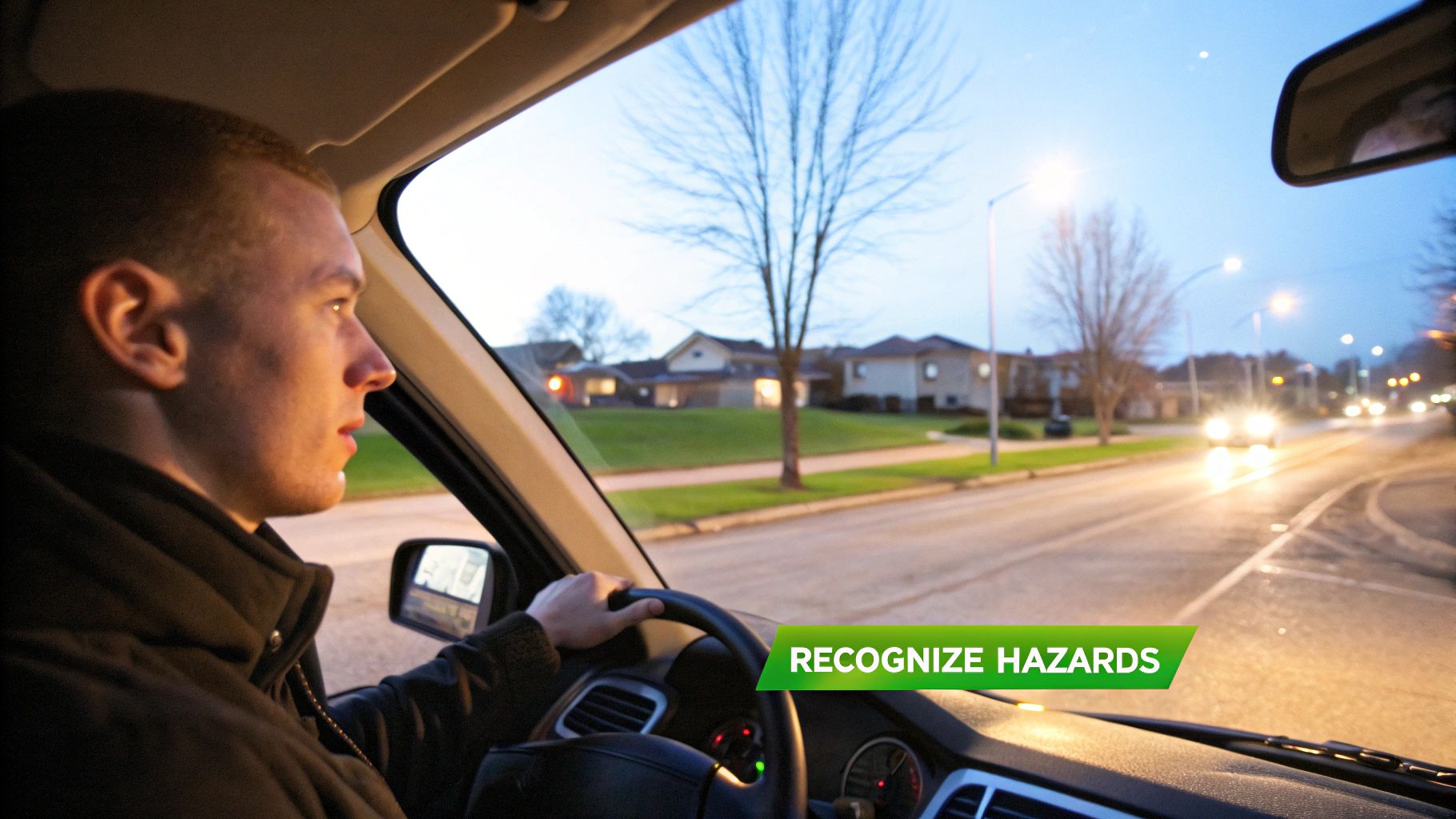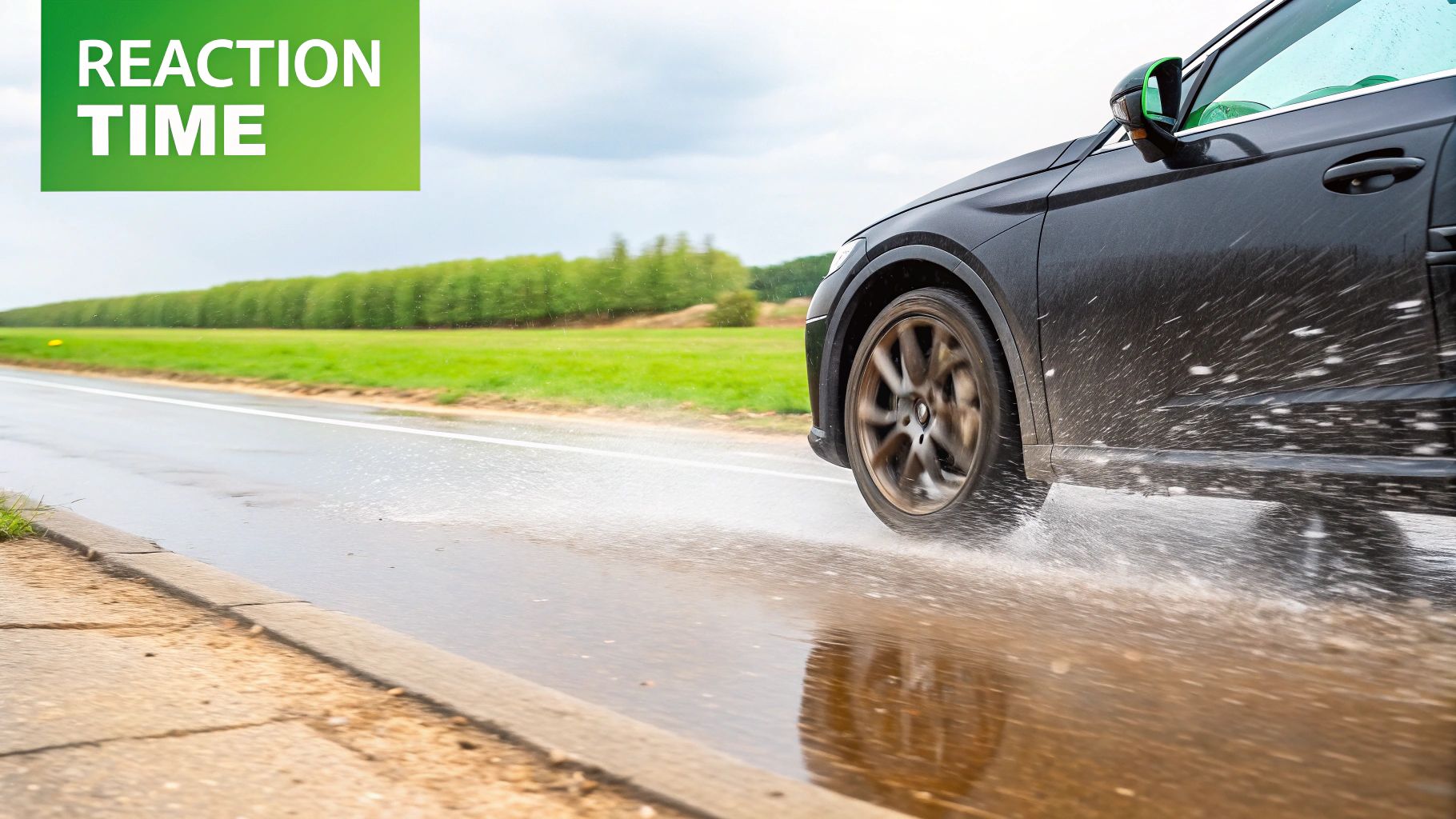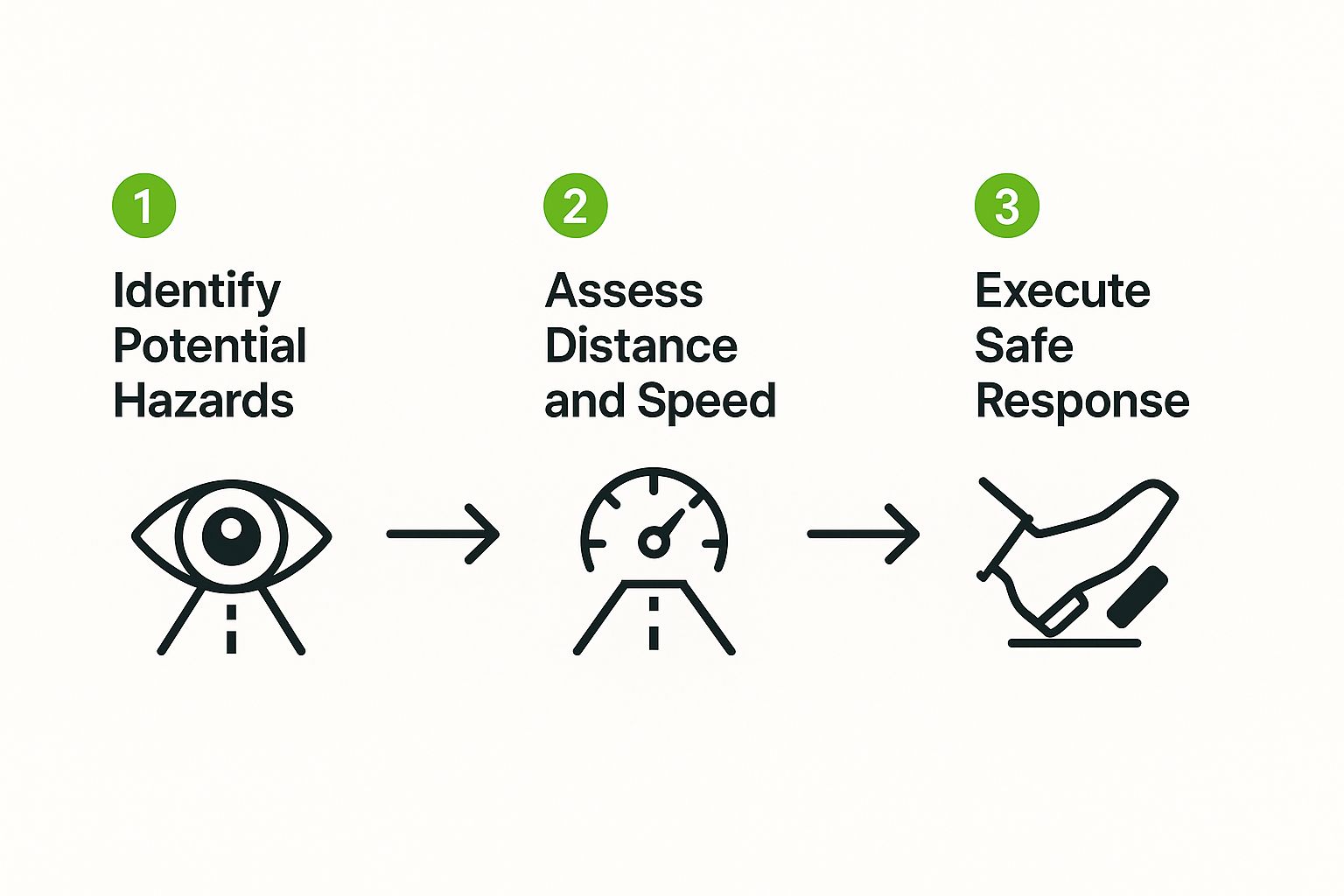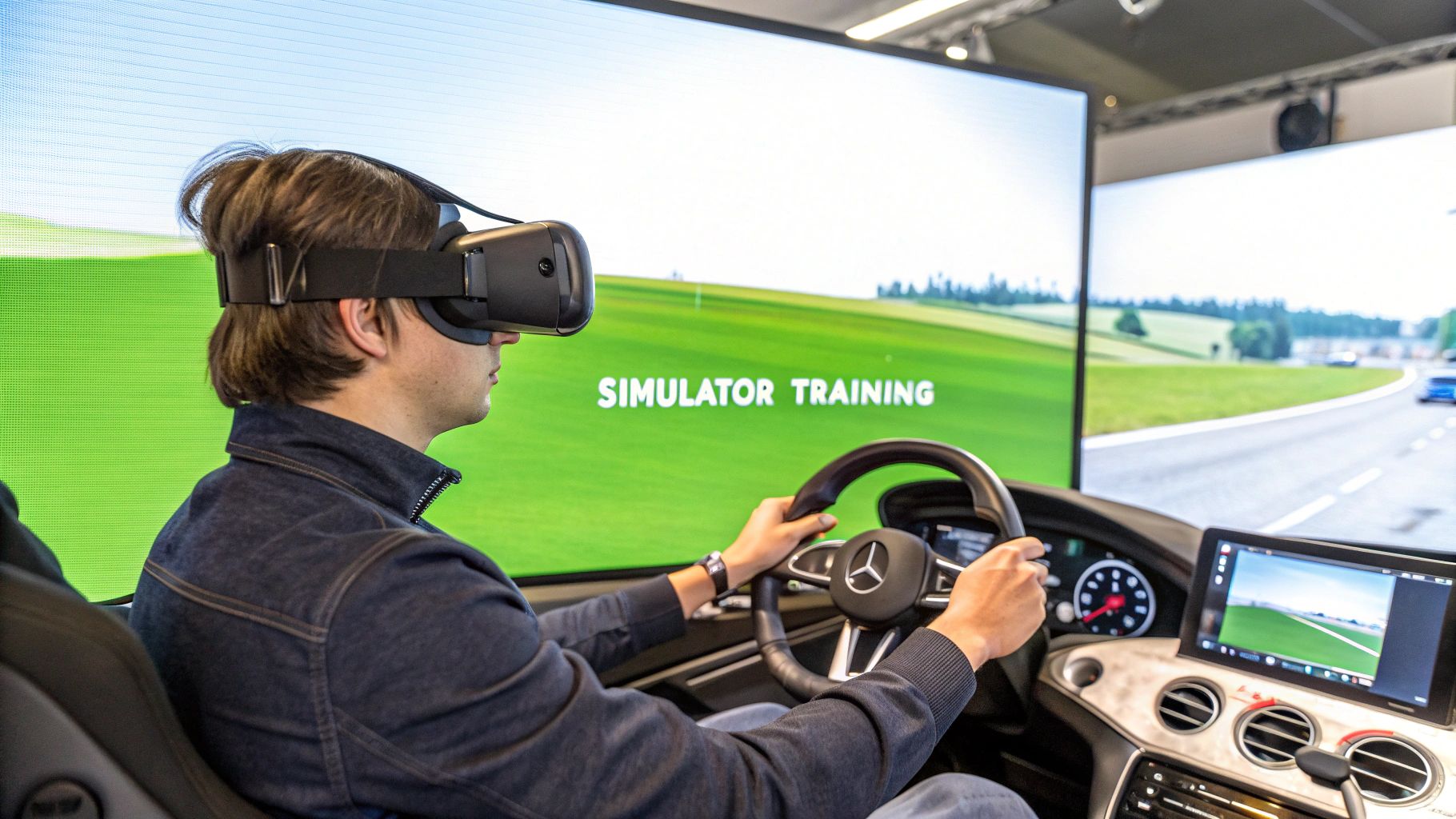Mastering the UK Hazard Perception Test: What You Need to Know

The UK driving test includes a critical component: the hazard perception test. This test evaluates your skill in identifying and reacting to potential dangers on the road. It's not simply about passing; it's about developing safe driving habits. This section outlines everything you need to know for success.
Understanding the Hazard Perception Test Format
The test consists of watching computer-generated video clips depicting various driving situations. Each clip contains at least one developing hazard. This is a situation that is about to create a dangerous situation, requiring a response from you. Examples include a pedestrian stepping into the street or a car pulling out from a junction. You must identify these developing hazards and click the mouse as soon as you see them emerging.
How Scoring Works: Timing is Key
The scoring system emphasizes reaction time. You can earn up to five points for each hazard, with quicker identification resulting in higher scores. Random or frantic clicking won't work. The system detects and penalizes click-happy behavior. Therefore, practice is vital for recognizing dangers early and reacting appropriately.
The Importance of Hazard Perception Practice
Effective practice hones your ability to anticipate potential dangers. This proactive approach can prevent accidents. Furthermore, practice builds confidence, enabling you to remain calm and focused during the actual test. Responding well under pressure is invaluable for any driver.
Hazard perception practice in the UK has changed significantly over time. The goal has always been to accurately reflect real-world driving scenarios. The move to computer-generated clips in 2015 increased control and consistency in presenting hazards. For further information and statistics, you can Explore this topic further. These changes highlight the ongoing dedication to improving road safety through better driver training and assessment. Understanding this evolution and practicing effectively are crucial for succeeding on the test and staying safe on UK roads.
The Psychology Behind Spotting Road Dangers Before They Happen

Hazard perception isn't simply about reacting; it's about anticipating what might happen next. This involves a complex interplay of visual skills, focused attention, and accumulated experience. Understanding these psychological principles can significantly improve your hazard perception practice.
Visual Scanning and Attention
Effective drivers don't just fix their gaze straight ahead. They actively scan the road environment, using a systematic pattern to absorb crucial information. This visual scanning acts like a radar sweep, detecting potential dangers. However, even with diligent scanning, your attention span can be a limiting factor.
Think of your attention as a spotlight – it can only illuminate a limited area at any one time. Distractions, both within the vehicle and from the surrounding environment, can narrow that spotlight, potentially causing you to miss vital clues.
Prediction and Experience
Experienced drivers often seem to have a sixth sense for danger. This isn't some mystical ability; it's prediction based on experience. Over time, drivers develop the skill of anticipating typical road user behaviors.
They recognize subtle cues, such as a pedestrian glancing at their phone or a car decelerating near an intersection. This predictive ability allows them to anticipate and prepare for potential hazards before they fully materialize. Understanding the mental processes behind these decisions is crucial; for further insights, consider exploring the psychology of decision-making by researching the Psychology of Marketing.
The Impact of Hazard Perception Practice
Hazard perception practice strengthens these essential mental skills. Repeated exposure to various driving scenarios helps build a mental library of potential hazards. This reinforces effective scanning patterns, improves the ability to filter distractions, and sharpens predictive skills.
This dedicated practice translates into safer driving habits, extending beyond simply achieving a passing score on a test. The implementation of hazard perception tests has demonstrably improved road safety in the UK. Since 2002, the introduction of this test has contributed to a 17.4% reduction in non-low speed accidents attributable to driver error. More detailed statistics are available here. This underscores the importance of hazard perception practice for all drivers.
5 Game-Changing Hazard Perception Practice Techniques

This infographic illustrates the three core steps involved in hazard perception: identifying potential hazards, assessing their distance and speed, and executing a safe response. These steps build upon each other, creating a continuous cycle of awareness and reaction crucial for safe driving. It’s important not only to spot the hazard but also to understand its potential impact and react accordingly.
Truly improving your hazard awareness goes beyond passively watching practice clips. It requires active practice techniques that hone your skills. This section explores five game-changing techniques used by expert driving instructors.
Progressive Scanning: Mastering The Art Of Observation
Progressive scanning involves systematically moving your eyes across the road, covering different areas in a structured manner. This technique helps prevent fixation, where your gaze locks onto a single point, potentially causing you to miss critical developments. Start by practicing a left-to-right scan, then incorporate mirror checks and observing further distances. This develops your ability to absorb maximum visual information while driving.
Commentary Driving: Speak Your Way To Safety
This technique might feel unusual initially, but it offers significant benefits. Commentary driving involves verbalizing potential hazards as you observe them. For example, say "Pedestrian approaching crossing" or "Car indicating right turn ahead." This actively engages your brain, sharpening your focus and increasing your awareness of developing situations.
Pattern Recognition: Spotting The Subtle Clues
Developing hazards often reveal subtle clues before becoming obvious. Pattern recognition trains you to spot these signs. Notice a pedestrian's change in pace or body language suggesting they might enter the road. This skill allows you to anticipate potential hazards. Regularly practice identifying these patterns to react proactively.
Timed Response Drills: Sharpening Your Reactions
Quick reactions are essential for hazard perception. Timed response drills improve your speed and accuracy. Use practice clips and focus on clicking as soon as a developing hazard appears. Monitor your response times and strive for consistent improvement. This enhances your ability to react quickly and appropriately to dangerous situations.
Mock Test Simulations: Putting It All Together
Regular mock tests are invaluable. They provide a realistic testing experience, reducing anxiety and building confidence. Analyze your performance on each mock test to identify areas for improvement. This translates to greater confidence and better performance during your actual test.
To help you understand the different techniques and their application, let's look at a comparison table:
Hazard Perception Practice Techniques Comparison
A comparison of different practice techniques, their benefits, implementation difficulty, and effectiveness for different learning styles.
| Technique | Primary Skill Developed | Practice Time Required | Difficulty Level | Effectiveness Rating |
|---|---|---|---|---|
| Progressive Scanning | Observation, Peripheral Vision | 10-15 minutes/session | Easy | High |
| Commentary Driving | Hazard Awareness, Focus | 15-20 minutes/session | Medium | High |
| Pattern Recognition | Anticipation, Predictive Skills | Varies, ongoing observation | Medium | High |
| Timed Response Drills | Reaction Time, Accuracy | 5-10 minutes/session | Easy | Medium |
| Mock Test Simulations | Overall Test Performance, Confidence | 30-45 minutes/test | Medium | High |
This table summarizes the key aspects of each technique, allowing you to tailor your practice based on your individual needs and learning style. By integrating these five techniques into your practice, you'll develop robust skills and confident reactions that extend beyond simply passing the test. They contribute to a lifetime of safer driving.
The Hazard Perception Mistakes That Fail Most Learners
The hazard perception test is a challenge for many learner drivers. Let's explore some common pitfalls, drawing on insights from driving instructors and test examiners, to understand why so many learners miss out on top marks. Knowing what these mistakes are is the first step to improving your hazard perception practice.
The Click-Happy Trap
Many learners fall into the click-happy trap. They click frantically, thinking any movement on the screen deserves a click and hoping to pick up points. Unfortunately, the scoring system penalizes this approach. Random, multiple clicks will lower your score. Disciplined timing, not rapid clicking, is the key. Focus on quality clicks over quantity. Improving your hazard perception requires focused attention, and one way to improve focus is through regular practice writing.
Delayed Reactions: Spotting vs. Responding
Another common problem is delayed reactions. A learner might spot the hazard, but their click comes too late to earn maximum points. This highlights the critical difference between recognizing a hazard and reacting to it. Hesitation, or a lack of confidence in judging how a hazard is developing, often causes this delay. Practice is essential for training your brain to respond quickly and decisively.
Potential vs. Developing Hazards: Understanding The Difference
Distinguishing between potential hazards and developing hazards can be tricky. A potential hazard could become dangerous. A developing hazard is actively becoming dangerous, requiring a response. A parked car is a potential hazard. But, if the brake lights go off and the driver signals, it's now a developing hazard. This requires a prompt click in the test.
Screen Fixation: Overcoming Nervousness
Screen fixation affects many learners, especially those who are nervous about the test. They stare intently at the center of the screen, missing hazards developing in their peripheral vision. Real-world driving requires observing the whole scene. Practice with diverse scenarios to train your eyes to scan effectively, not just fixate on one spot. This builds overall awareness and improves performance on the actual test. Techniques like progressive scanning, systematically moving your eyes across the scene, can help you avoid this. Remember, the key to effective hazard perception practice is identifying developing hazards quickly and accurately, not just clicking a lot.
The Ultimate Hazard Perception Practice Resource Guide

Preparing for the hazard perception segment of the UK driving test can be challenging. Finding effective practice resources is key to developing the skills you need. This guide explores a range of options, from official DVSA materials to third-party apps and free online resources, to help you choose the best tools for your learning journey.
Official DVSA Resources: The Gold Standard
The DVSA (Driver and Vehicle Standards Agency) offers official practice materials designed to mirror the actual test. These resources are essential for understanding the test format, question types, and scoring system. They provide a strong foundation for your hazard perception preparation. The DVSA’s guide to hazard perception is a great starting point, and working through the official practice tests is a reliable way to gauge your progress.
Third-Party Apps: Practice on the Go
Many third-party apps offer hazard perception practice, providing a convenient way to prepare anytime, anywhere. However, the quality of these apps can vary. Look for apps offering realistic scenarios, clear feedback on your performance, and progress tracking features. Some apps emphasize detailed explanations of developing hazards, while others focus on quick reaction times. Consider your learning style and budget when choosing an app, as pricing models range from one-time purchases to ongoing subscriptions.
Free Resources: Smart Choices For Effective Learning
Free online resources can be a valuable addition to your hazard perception practice, particularly as you build your skills. Numerous websites offer free practice clips and quizzes. The key is to choose wisely, prioritizing resources that align with the current DVSA test format. Combining free resources with official DVSA materials can provide a comprehensive and cost-effective preparation strategy.
Choosing The Right Resources: Features To Consider
Selecting the right resources from the many available options can be overwhelming. To help you make informed decisions, we've compiled a comparison table highlighting key features:
To help you navigate the various options available, the following table compares several popular resources:
Hazard Perception Practice Resources
A comparison of available practice resources including official DVSA materials, apps, and online platforms.
| Resource | Platform | Cost | Realism Rating | Features | User Rating |
|---|---|---|---|---|---|
| Official DVSA Materials | Online, Books | Varies | Excellent | Aligns perfectly with the test | Excellent |
| Theory Test Pro | Mobile, Web | Subscription | Very Good | Progress tracking, detailed explanations | Very Good |
| Driving Test Success | Mobile | One-time purchase | Good | Focus on timed responses | Good |
| Free Online Practice Clips | Various Websites | Free | Varies | Supplement to other resources | Varies |
This table emphasizes the importance of considering factors like platform, cost, realism, and features when choosing resources. Remember, the most expensive option isn't necessarily the best. The key is finding materials that suit your individual learning style and budget.
Combining Resources: Maximising Your Improvement
Using a combination of resources often yields the most effective preparation. For example, start with official DVSA materials to establish a solid understanding of the test format. Then, incorporate a third-party app for regular practice on the go. Supplement your practice with free online clips to target specific skills or reinforce areas where you need improvement. This blended approach allows you to leverage the strengths of each resource, maximizing your chances of test success. More importantly, it helps you develop the crucial real-world driving skills needed to identify and react to potential hazards on the road. Fast Pass Driving Courses can provide further support and expert instruction throughout your driving journey.
Your Week-by-Week Hazard Perception Success Plan
Passing the hazard perception test isn't simply about clicking when you see something; it's about developing a real awareness of the road. This awareness comes from hazard perception practice, and we've created a plan to help you, whether you have one week or several months to prepare.
One-Week Intensive Plan
If your test is just a week away, intensive practice is key.
- Daily: Set aside 30-45 minutes for practice clips. Be sure to cover a variety of scenarios including urban areas, rural roads, and motorways.
- Key Focus: The goal is to recognize developing hazards early. Don't wait for the danger to become obvious. Practice recognizing those subtle cues.
- Measurement: Monitor your scores on practice tests. Pay close attention to improving your response time.
This short, focused plan maximizes practice and helps you quickly spot hazards.
One-Month Progressive Plan
With a month to prepare, a more progressive approach is recommended.
- Week 1: Familiarize yourself with the test format. Use official DVSA materials to understand the structure and expectations.
- Week 2: Concentrate on specific techniques like commentary driving and progressive scanning. These techniques can help you systematically assess the road.
- Week 3: Begin timed response drills. This will hone your reaction speed and improve your accuracy under pressure.
- Week 4: Take full mock tests under timed conditions. This simulates the real test environment and helps you manage test-day nerves.
- Measurement: Track your scores weekly. Identify your weaker areas and concentrate your practice on those.
Three-Month Mastery Plan
Three months offers a chance to achieve a deeper understanding.
- Month 1: Build a strong foundation. Focus on understanding the theory behind hazard perception and how it applies to real-world driving.
- Month 2: Explore advanced practice techniques. Utilize a variety of resources to challenge yourself with different scenarios.
- Month 3: Refine your skills with timed mock tests. Combine your hazard perception practice with on-road driving lessons with a qualified driving instructor.
- Measurement: Regularly assess your progress. Note how your instructor reacts to potential dangers during your lessons and apply these observations to your practice sessions.
Spacing Out Your Practice: The Key To Retention
Why not cram all your practice into a few days? Research indicates that spaced repetition dramatically improves retention. Consistent practice over time builds lasting skills, not just short-term memory. Combining hazard perception practice with actual driving lessons helps you apply your skills in real situations, improving your overall driving ability.
No matter which plan you choose, remember that consistency is key. Regular practice sessions, even short ones, are much more effective than infrequent, longer ones. These plans aren’t designed just to help you pass the test; they’re designed to help you navigate UK roads safely and confidently for years to come.
Ready to elevate your driving skills? Book your intensive or semi-intensive driving course with Fast Pass Driving Courses today!

